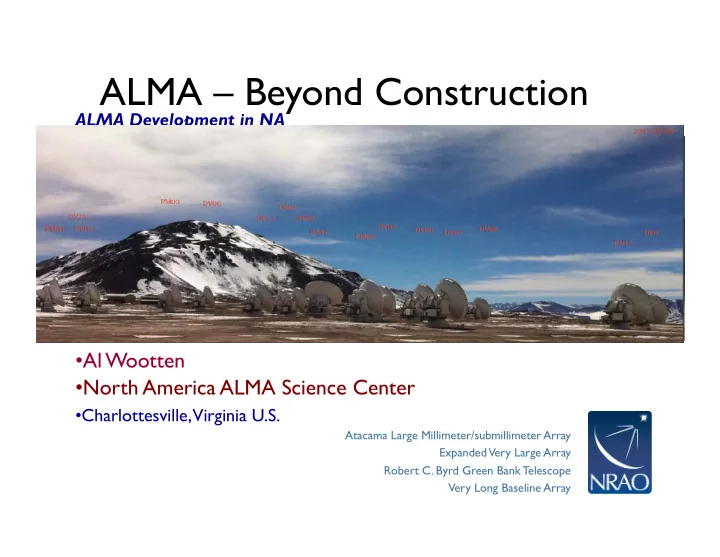

ALMA – Beyond Construction ALMA Development in NA • Al Wootten North America ALMA Science Center • • Charlottesville, Virginia U.S. Atacama Large Millimeter/submillimeter Array Expanded Very Large Array Robert C. Byrd Green Bank Telescope Very Long Baseline Array
ALMA Development/NA • Process began with March 2011 Workshop to collect response and ideas for a Call for Development Studies patterned after the earlier Eu Call • Good response resulted in a refined draft Call, distributed to other entities among the NA partners and to NSF • In response to that draft, a further refinement has been made and will soon be submitted to NSF seeking development study proposals from among North American entities • A Software Development Workshop will be held at NRAO 12-14 Oct 2011 • Aim is to come up with a set of ideas for so;ware applica<ons that will enhance the science output from ALMA • Some topics include • Line forest analysis Feature finding in large datacubes • Matching data to simula<ons • Visualiza<on • Compressive Sensing • ALMA/NA Development Update
Current NA Timeline • Concurrently with Call, refinement of the implementa<on plan • Call for Studies ‘soon’ – To include hardware and so;ware – BeKer defini<on of so;ware a;er Oct workshop • Evalua<on winter 2011/2 by external‐to‐NRAO commiKee – ANASAC involvement • Kick‐off for Studies early 2012 ALMA/NA Development Update
ANASAC: B1 Frequency Range • ANASAC charge : The ANASAC is asked to comment on the scien<fic advantages of resi<ng ALMA Band 1 in frequency from 31.3‐45 GHz to e.g. 34‐53 GHz. Please note scien<fic advantages for the loca<ons of the upper and lower edges of the band. Note that a paper on science goals of Band 1 is available in arXiv:0910.1609. • ALMA may provide beKer complementarity to the eVLA if opera<ng at higher B1 frequencies. – At these frequencies ALMA ~30 <mes faster for a point source (same beam) and covers 4x the field of view – Opposing hemispheres • Propose (Dra;) that Development proposers recommend that the specifica<ons for Band 1 be broadened to allow for the development of the most effec<ve and efficient receiver consistent with ALMA design with a frequency range anywhere from 31GHz to 51 GHz – Designing outside the approved range will require some redesign, which must be included in a Development proposal. ALMA/NA Development Update
Science Drivers • Frequency range: 31‐45 GHz only loosely driven scien<fically. – for con<nuum studies the effect of going to higher frequencies is a wash – anomalous dust observa<ons : frequency varia<on with density is so far uncertain • Line studies: no major loss moving the range higher‐‐beKer for high‐z CO studies. Some Line target gains: – CCS 4_3‐3_2 45.38 GHz • Considered and early‐stage molecule and magne<c field tracer through Zeeman measurements – Ground State CS lines (with isotopologues) ‐ note only 2.5 GHz apart • CS 1‐0 48.99 GHz • C$^33$S 1‐0 48.58 GHz • C$^34$S 1‐0 48.21 GHz • $13$CS 1‐0 46.25 GHz – CH$_3$OH 1_0‐0_0 48.37 GHz Ground state methanol – H$_2$CO 4_13‐4_14 48.28 GHz density tracer unaffected by op<cally thick dust – NH$_2$D 2(2,0)‐2(2,1) 49.96 GHz and 3(1,3)‐3(0,3) 43.04 GHz deutera<on and excita<on tracer (line ra<o good for temperatures in the range 0‐100K) ALMA/NA Development Update
Recommend
More recommend